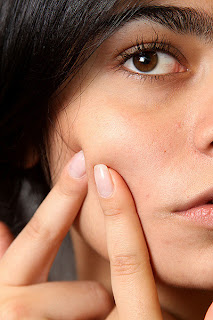The skin is our body's largest organ. Changes in skin appearance may be caused by something as minor as acne or they can signal a more serious underlying condition. Rashes, strange spots, itchiness, and other changes in texture and color may be the result of infection, allergic reaction, or other chronic skin disorder. Listed below are some common adult skin problems at a glance. Incidence varies depending on your age and other factors like skin types, racial background, and occupation.
1. Acne
Around 80% of Americans will have acne at some point in their lives. Incidence in both men and women peaks in the teenage years is because of hormonal influence. Acne is the most common skin condition especially in young adult, but it's usually the least severe.
Acne is a skin condition that causes pimples which occurs when the tiny pores on the surface of the skin become clogged. When glands produce too much oil, the skin pores can become blocked and dirt, bacteria, and cells build up. Acne may come in many forms such as whiteheads, blackheads, papules, pustules, or nodular and cystic acne which may leave scars. The most common locations affected are the face, neck, shoulders, chest and back.
2. Eczema
Eczema or dermatitis is a term used to describe a group of conditions where skin is inflamed, red, dry, and itchy. It is a chronic noncontagious condition that may come and go over time. The exact cause is unknown, but stress, allergens, chemical irritants like soap or cosmetics, and weather changes can trigger flare-ups.
There are three types of dermatitis: atopic dermatitic, allergic contact dermatitis, and nummular dermatitis. Atopic dermatitis is usually seen in children and many people outgrow it by adulthood. In adult, it often occurs on the hands and feet, and in bending areas such as inside the elbows and behind the knees. Allergic contact dermatitis usually starts in adulthood and is related to allergens in fragrances, cosmetics, or metallic elements. Nummular dermatitis is a condition in which itchy, coin-shaped spots or patches appear on the skin. It usually affects elderly men.
3. Moles
Moles or nevi are very common. Almost every adult, especially people with light skin, has a few moles that generally appears in teenage years until the middle ages. A number of 10 to 40 moles is normal. Moles can grow anywhere on the body in form of black or brown spots. Some moles may undergone changes in size and colors over the years. While most are harmless, some moles have a higher risk of becoming cancerous. If a mole starts to grow, itch, or bleed, make an appointment to see a dermatologist and have it evaluated.
4. Hives
Also known as urticaria, hives are raised, often itchy, red welts (wheals) on the surface of the skin. They are usually an allergic reaction to foods, medicines, temperature changes, and bacterial or viral infections. Hives may appear anywhere on the body varying in sizes and may last from minutes to days. They are generally harmless and disappear on their own, but a small number of cases can develop into severe allergic reaction called anaphylaxis. Seek emergency help if your hives are accompanied by tongue or face swelling and shortness of breath.
5. Psoriasis
Psoriasis causes skin rashes and irritation with thick red plaques covered with white or silvery scales. The condition usually begins between ages 15 to 35 and may come and go throughout life. It usually affects the elbows, knees, and lower back. Certain forms affect particular areas like the hands, scalp or the joints. Psoriarsis is non contagious and the exact cause is unknown. However, the immune system seems to play an important part in the development of this disease and it is now proposed that psoriasis is an autoimmune disorder.
6. Warts
Warts are small, usually painless growths on the skin caused by a virus called human papillomavirus (HPV). Common warts usually appear on the fingers or hands. They usually do not cause pain unless they are repeated rubbed against. Warts spread from person to person or via direct contact or indirectly through things used by a person with the virus. In most cases, warts are harmless, painless, and go away on their own.
7. Shingles
Shingles or herpes zoster is a painful, blistering skin rash caused by the varicella-zoster virus, the same virus that causes chickenpox. It usually starts with burning, tingling, or painful rash which develop into blisters that last about two to three weeks. Shingles may develop in any age group, but elderly people and those with weakened immune system are at higher risk. It can appear anywhere, but often affects the trunk, buttocks, or the face. Most people recover, but sometimes the pain in the area where the shingles occurred may last from months to years.
